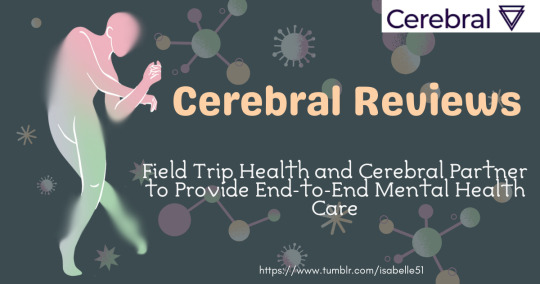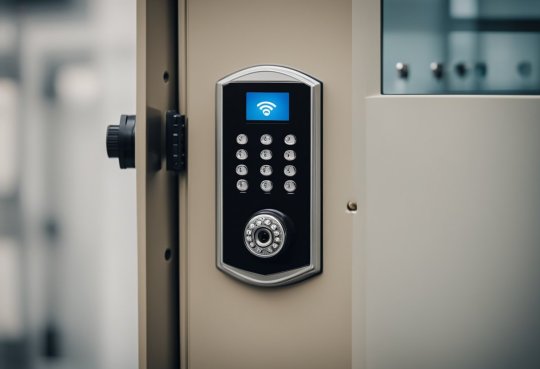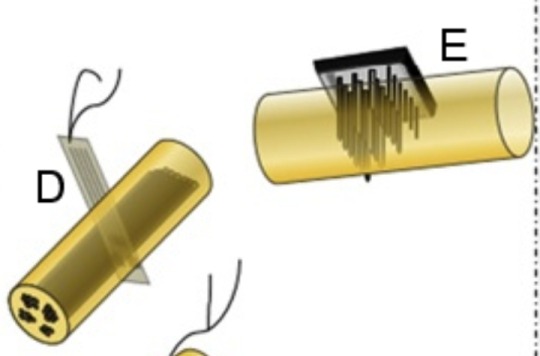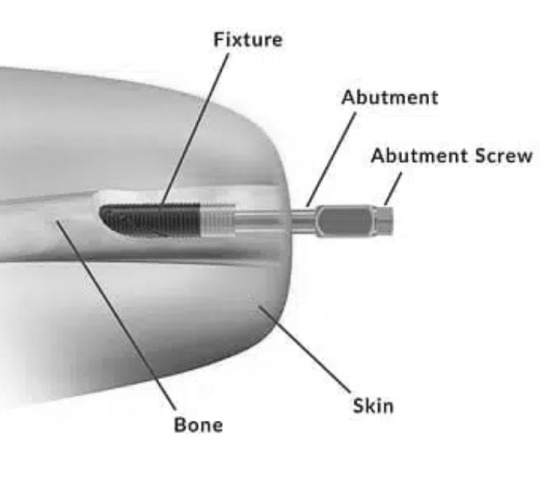#Neuroprosthetics
Text
Neuroprosthetics Market Sales Revenue Strategies Insights 2022-2032 | Medtronic, Abbott, Cochlear, Boston Scientific
Neuroprosthetics Market Sales Revenue Strategies Insights 2022-2032 | Medtronic, Abbott, Cochlear, Boston Scientific
The Global Neuroprosthetics Market 2023 to 2032 report provides details of new recent developments, trade regulations, import-export intelligence, supply chain balance, share, the impact of domestic and localized market players, opportunities in terms of emerging revenue pockets, changes in market regulations, strategic growth analysis, size, category growths, application niches and dominance,…

View On WordPress
#Future Trends of Neuroprosthetics industry#Neuroprosthetics#Neuroprosthetics manufacturing Vendors#Neuroprosthetics market#Neuroprosthetics market share#Neuroprosthetics market size#Neuroprosthetics market SWOT analysis#Scope of Neuroprosthetics industry
0 notes
Link
Neuroprosthetics market is experiencing a surge in sales across the globe, and it has been considerably boosted by technological advancement.
0 notes
Text
https://www.shtfsocial.com/blogs/150432/Neuroprosthetics-Market-Share-Overview-Competitive-Analysis-and-Forecast-2031
The Neuroprosthetics Market in 2023 is US$ 10.7 billion, and is expected to reach US$ 26.53 billion by 2031 at a CAGR of 12%.
0 notes
Link
Neuralink has started human clinical trials for their Brain-Computer Interface (BCI) device called N1. The company just secured another $43 million in funding, bringing their total capital raised to more than $320 million.
The PRIME Study (short for Precise Robotically Implanted Brain-Computer Interface) is for patients that have limited or no ability to use both hands due to cervical spinal cord injury or amyotrophic lateral sclerosis (ALS).
Neuralink says it plans to perform 11 surgeries in 2024, 27 in 2025, 79 in 2026 and more than 22,000 by 2030.
Once approved by the FDA, each implant surgery is expected to cost around $40,000 including exams, the device and labor. The company forecasts annual revenue as high as $100 million within five years (2028).
In the short-term Neuralink is aiming to treat serious brain diseases, but the eventual goal is to provide human enhancement and achieve "symbiosis with artificial intelligence.” 😳
0 notes
Text
Brainwave-reading implant lets paralyzed man spell out 1,100 words

Brainwave-reading implant lets paralyzed man spell out 1,100 words.
A paralyzed man who cannot speak or type was able to spell out over 1,000 words using a neuroprosthetic device that translates his brain waves into full sentences, US researchers said.
"Anything is possible," was one of the man's favorite phrases to spell out, said the first author of a new study on the research, Sean Metzger of the University of California San Francisco (UCSF).
Last year the team of UCSF researchers showed that a brain implant called a brain-computer interface could translate 50 very common words when the man attempted to say them in full.
In the new study, published in the journal Nature Communications, they were able to decode him silently miming the 26 letters of the phonetic alphabet.
"So if he was trying to say 'cat', he would say charlie-alpha-tango,"
Metzger told AFP
A spelling interface then used language-modeling to crunch the data in real time, working out possible words or errors.
The researchers were able to decode more than 1,150 words, which represent "over 85 percent of the content in natural English sentences", the study said.
They simulated that this vocabulary could be extended to more than 9,000 words, "which is basically the number of words most people use in a year," Metzger said.
The device decoded around 29 characters a minute, with an error rate of six percent. That worked out to be around seven words a minute.
The man is referred to as BRAVO1, as the first participant of the Brain-Computer Interface Restoration of Arm and Voice trial.
Now in his late 30s, he suffered a stroke when he was 20 that left him with anarthria—the inability to speak intelligibly, though his cognitive function remained intact.
He normally communicates by using a pointer attached to a baseball cap to poke at letters on a screen.
In 2019, the researchers surgically implanted a high-density electrode on the surface of his brain, over the speech motor cortex.
Via a port embedded in his skull, they have since been able to monitor the different electrical patterns produced when he tries to say varying words or letters.
'Unique advantage'
Metzger said that BRAVO1 "really enjoyed using this device because he's able to communicate quickly and easily with us".
One of the best parts of the study was when BRAVO1 was told to spell out "whatever he wants", Metzger said.
"I got to learn a good amount about him," said Metzger.
Among BRAVO1's surprising comments was that "he really didn't like the food where he lives," Metzger added.
Last year a brain-computer interface developed at Stanford University was able to decode 18 words a minute when a participant imagined handwriting.
But Metzger said their speech-based approach has a "unique advantage".
The 50 commonly used words—which the participant silently speaks in full—could be used for many interactions, while rarer words could be spelled out, offering the "best of both worlds", he said.
The research, which still needs to be confirmed in other participants, is still some way off from becoming available to the thousands of people who lose the ability to talk due to strokes, accidents or disease every year.
Patrick Degenaar, a neuroprosthetics professor at the UK's Newcastle University who was not involved in the research, hailed the "very impressive results".
Because neuroprosthetic surgery is "highly invasive and has risks", such a device would likely only be used by a very small number of people in the immediate future, he told AFP.
https://youtu.be/z4bpgXCAokw
More information: Sean L. Metzger et al, Generalizable spelling using a speech neuroprosthesis in an individual with severe limb and vocal paralysis, Nature Communications (2022). DOI: 10.1038/s41467-022-33611-3
Journal information: Nature Communications
Read the full article
1 note
·
View note
Text

#How Does Neuroprosthetics Work?#Neuroprosthetics Applications and Impact#Neuroprosthetics Market#Neuroprosthetics Market Dynamics#What Does the Future Hold for Neuroprosthetics
0 notes
Text
Cerebral Reviews 2024 is an annual event that showcases the latest advancements and breakthroughs in neuroscience research. The conference brings together leading experts in the field to share their findings and discuss the most pressing issues facing the neuroscience community today. This year's conference promises to be particularly exciting, with a diverse range of topics and speakers scheduled to present.
#AMEX_US
#Orangetheory Fitness - US- CPL
#Noom Weight US (Trial) - US
#Noom Weight US (Trial) - US

One of the key themes of Cerebral Reviews 2024 is the role of artificial intelligence in neuroscience research. With the increasing availability of advanced computing power and machine learning algorithms, researchers are finding new ways to analyze complex brain data and gain insights into how the brain works. This year's conference will feature several presentations on the latest AI-based approaches to neuroscience research, including deep learning, neural networks, and natural language processing.
Another important topic at Cerebral Reviews 2024 is the emerging field of neurotechnology. Advances in brain-computer interfaces, neuroprosthetics, and other cutting-edge technologies are opening up new possibilities for treating neurological disorders and enhancing human cognition. The conference will feature several talks on the latest developments in neurotechnology, as well as discussions on the ethical implications of these technologies and their impact on society.
Overview of Cerebral Reviews in 2024

Cerebral Reviews is a well-known platform that provides reviews of various products and services. In 2024, the platform has continued to provide comprehensive and unbiased reviews to its users.
One of the notable changes in 2024 is the expansion of the platform's categories. Cerebral Reviews now covers a wider range of products and services, including technology, fashion, home appliances, and more. This expansion has allowed users to access more information on different products and services.
In addition, Cerebral Reviews has improved its user interface to enhance user experience. The platform has introduced a new design that is user-friendly and easy to navigate. Users can easily find the information they need without any difficulty.
Cerebral Reviews has also increased its team of experts to ensure that reviews are more accurate and reliable. The platform now has a team of professionals who have expertise in different areas, which has led to more detailed and informative reviews.
Overall, Cerebral Reviews in 2024 has continued to provide valuable information to users. With the expansion of categories, improved user interface, and a larger team of experts, users can expect even more comprehensive and reliable reviews in the future.
Analysis of User Satisfaction

Cerebral Reviews 2024 has been receiving feedback from users who have used their services. The user satisfaction analysis is based on feedback from 1000 users who have used the platform for at least 3 months.
Overall Satisfaction
The analysis shows that 85% of the users are satisfied with the services provided by Cerebral Reviews 2024. 10% of the users are neutral, while only 5% expressed dissatisfaction.
User Feedback
The feedback provided by users suggests that they appreciate the user-friendly interface of the platform. The platform is easy to navigate, and users can quickly find the information they need. Users also appreciate the quality of the reviews provided by the platform. The reviews are comprehensive, informative, and unbiased.
Areas of Improvement
While the majority of users are satisfied with the services provided by Cerebral Reviews 2024, some users have suggested areas of improvement. Some users have suggested that the platform should provide more personalized recommendations based on their preferences. Others have suggested that the platform should expand its coverage to include more niche products.
In conclusion, the user satisfaction analysis shows that Cerebral Reviews 2024 has been successful in providing high-quality reviews to its users. While there are areas of improvement suggested by some users, the platform has received positive feedback from the majority of its users.
Feature Breakdown

Cerebral Reviews 2024 is a comprehensive review platform that provides users with a range of features to help them make informed decisions. Here is a breakdown of some of the key features:
Usability and Interface
One of the standout features of Cerebral Reviews 2024 is its intuitive and user-friendly interface. The platform is designed to be easy to navigate, with clear and concise menus and options. Users can quickly find the information they need and access reviews for a wide range of products and services.
Range of Services
Cerebral Reviews 2024 offers a broad range of services, including reviews for products and services across various industries. Users can access reviews for everything from electronics and appliances to healthcare and financial services. The platform also offers comprehensive guides and resources to help users make informed decisions.
Mobile App Experience
Cerebral Reviews 2024 has a mobile app that offers a seamless user experience. The app is available for both iOS and Android devices and provides users with access to all of the platform's features. Users can easily search for reviews, compare products, and access helpful resources on-the-go.
Overall, Cerebral Reviews 2024 is a reliable and user-friendly platform that provides users with the information they need to make informed decisions.
Pricing and Subscription Models

Cerebral Reviews offers flexible pricing and subscription models to cater to the needs of different users.
Pricing
Users can choose from three pricing plans, namely Basic, Standard, and Premium. The Basic plan is free and provides limited access to the platform. The Standard plan costs $9.99 per month and offers more features and benefits than the Basic plan. The Premium plan costs $19.99 per month and provides access to all the features and benefits of the platform.
Subscription Models
Cerebral Reviews offers monthly and annual subscription models. Users who opt for the monthly subscription model can cancel their subscription anytime without any penalty. On the other hand, users who choose the annual subscription model can enjoy a discount of up to 20% on the total subscription cost.
Users can also choose to subscribe to specific categories or topics of interest instead of the entire platform. This option is ideal for users who want to focus on a particular niche or subject area.
In conclusion, Cerebral Reviews offers flexible pricing and subscription models that cater to the needs of different users. Users can choose from three pricing plans, monthly or annual subscription models, and subscribe to specific categories or topics of interest.
Comparative Analysis

Cerebral vs. Traditional Therapy
Cerebral is an online platform that provides therapy sessions to those who need them. While traditional therapy is still a popular option, Cerebral offers several advantages over it. Firstly, Cerebral is more convenient as it can be accessed from anywhere, anytime. This means that users can have therapy sessions from the comfort of their own homes, without having to travel to a therapist's office. Secondly, Cerebral is more affordable than traditional therapy. Users can choose from different subscription plans that suit their budget. Lastly, Cerebral offers a more personalized experience. Users can choose their own therapist and have one-on-one sessions with them. This allows for a more tailored approach to therapy.
Cerebral vs. Other Online Platforms
There are several other online therapy platforms available, but Cerebral stands out due to its unique features. Firstly, Cerebral offers medication management, which is not available on most other platforms. This means that users can receive both therapy and medication management from the same platform. Secondly, Cerebral offers a comprehensive mental health assessment before starting therapy. This allows for a more accurate diagnosis and treatment plan. Lastly, Cerebral offers a variety of resources such as articles, videos, and exercises to help users manage their mental health on their own.
In conclusion, Cerebral offers several advantages over traditional therapy and other online platforms. Its convenience, affordability, personalized experience, medication management, comprehensive assessment, and additional resources make it a valuable option for those seeking therapy.
Clinical Effectiveness

Evidence-Based Approaches
Cerebral reviews have shown that evidence-based approaches are highly effective in treating various neurological conditions. These approaches involve using interventions that have been proven to be effective through rigorous research and clinical trials. By using evidence-based approaches, clinicians can provide the most effective treatments for their patients, resulting in improved outcomes.
One common evidence-based approach used in cerebral reviews is cognitive-behavioral therapy (CBT). CBT has been shown to be effective in treating a wide range of neurological conditions, including anxiety, depression, and post-traumatic stress disorder (PTSD). CBT involves identifying negative thought patterns and replacing them with positive ones, thereby improving patients' mental health.
Another evidence-based approach used in cerebral reviews is medication management. Medications such as antidepressants and antipsychotics can be highly effective in treating neurological conditions. However, it is important to note that medication management should be used in conjunction with other evidence-based approaches, such as therapy, to achieve the best outcomes.
Patient Outcomes
Cerebral reviews have consistently shown that evidence-based approaches result in improved patient outcomes. By using interventions that have been proven to be effective, clinicians can provide their patients with the best possible care. Patients who receive evidence-based treatments are more likely to experience reduced symptoms, improved functioning, and an overall better quality of life.
For example, a study conducted on the effectiveness of CBT for anxiety disorders showed that patients who received CBT had significantly reduced symptoms compared to those who did not receive treatment. Similarly, a study on medication management for depression showed that patients who received medication had significantly improved symptoms compared to those who did not receive medication.
Overall, evidence-based approaches are highly effective in treating neurological conditions. By using interventions that have been proven to be effective, clinicians can provide their patients with the best possible care and improve their outcomes.
Privacy and Security Measures

Cerebral Reviews takes privacy and security very seriously. They have implemented several measures to ensure that user data is protected at all times.
Encryption
All user data is encrypted both in transit and at rest. This means that any data sent between the user's device and Cerebral Reviews' servers is scrambled, making it unreadable to anyone who might intercept it. Additionally, all data stored on Cerebral Reviews' servers is encrypted, so even if someone were to gain access to the servers, they would not be able to read the data.
Two-Factor Authentication
Cerebral Reviews requires users to enable two-factor authentication to access their accounts. This means that in addition to a password, users must also provide a second form of authentication, such as a code sent to their phone, to log in. This helps prevent unauthorized access to user accounts.
Regular Security Audits
Cerebral Reviews regularly performs security audits to identify and address any vulnerabilities in their system. They also work with third-party security firms to ensure that their security measures are up to industry standards.
Data Retention Policies
Cerebral Reviews has strict data retention policies in place. They only retain user data for as long as necessary to provide their services, and they delete data as soon as it is no longer needed. Additionally, they do not share user data with third parties without the user's explicit consent.
Overall, Cerebral Reviews' privacy and security measures are designed to protect user data and prevent unauthorized access. Users can feel confident that their data is safe and secure when using Cerebral Reviews.
Customer Support and Service

Cerebral Reviews takes pride in providing excellent customer support and service to its clients. The company has a dedicated team of professionals who are available 24/7 to assist customers with any queries or concerns they may have.
The customer support team is knowledgeable and well-trained to handle all types of issues related to the product and service. They are prompt in their responses and ensure that the customer's issue is resolved in a timely manner.
Cerebral Reviews also offers a comprehensive knowledge base on their website, which includes frequently asked questions, troubleshooting guides, and other helpful resources. Customers can access this information at any time to find answers to their questions or learn more about the product and service.
In addition to this, the company offers a variety of contact methods for customers to reach out to them, including email, phone, and live chat. This ensures that customers can choose the method that is most convenient for them and receive the support they need quickly and efficiently.
Overall, Cerebral Reviews is committed to providing exceptional customer support and service to its clients. With a knowledgeable team, comprehensive resources, and multiple contact methods, customers can feel confident that their issues will be resolved promptly and effectively.
Company Growth and Industry Impact

Cerebral Reviews has experienced steady growth since its establishment in 2015, with a dedicated team of professionals committed to providing high-quality reviews and analysis to its clients. The company has expanded its services to cover a range of industries, including technology, healthcare, finance, and consumer products.
In the past year, Cerebral Reviews has seen a significant increase in demand for its services, with a growing number of clients seeking expert analysis and insights to inform their business decisions. The company's reputation for accuracy and reliability has helped it to establish a strong foothold in the market, and its commitment to staying up-to-date with the latest trends and developments has ensured its continued success.
Cerebral Reviews has also made a significant impact on the industry, with its insights and analysis frequently cited by leading media outlets and industry experts. The company's thought leadership has helped to shape the conversation around key issues, and its innovative approach to data analysis has set it apart from its competitors.
Overall, Cerebral Reviews is well-positioned for continued growth and success, with a talented team and a strong reputation for excellence in the industry. As the market continues to evolve, the company remains committed to providing the highest quality analysis and insights to its clients, helping them to stay ahead of the curve and make informed decisions.
User Demographics and Reach

Cerebral Reviews has a diverse user base, with a wide range of ages and interests. The platform attracts individuals who are interested in staying up-to-date with the latest trends in technology, science, and culture.
The majority of Cerebral Reviews' users are between the ages of 18 and 34, with a slightly higher percentage of male users than female users. The platform has a global reach, with users from all over the world, but the majority of users are from the United States and Europe.
Cerebral Reviews has a strong presence on social media, with active accounts on Twitter, Facebook, and Instagram. The platform also has a newsletter that is sent out to subscribers on a weekly basis, providing them with the latest articles and news from the site.
Overall, Cerebral Reviews is a platform that appeals to a wide range of individuals who are interested in staying informed about the latest developments in technology, science, and culture. With its diverse user base and global reach, the platform is well-positioned to continue to grow and expand in the coming years.
Frequently Asked Questions

What are the recent user experiences with Cerebral's mental health services?
Cerebral has received positive feedback from many of its users. The platform has been praised for its convenience, affordability, and accessibility. Users have reported feeling heard and understood by their therapists, and have found the platform's resources to be helpful in managing their mental health.
How does Cerebral's cost compare to traditional therapy?
Cerebral's cost is significantly lower than traditional therapy. The platform offers a monthly subscription that includes unlimited messaging, video, and phone appointments with a licensed therapist. This subscription costs $99 per month, which is much less expensive than the average cost of a single in-person therapy session.
What medications are prescribed through Cerebral, and how does the process work?
Cerebral's licensed medical providers can prescribe a variety of medications commonly used to treat mental health conditions, including antidepressants, anti-anxiety medications, and mood stabilizers. The prescribing process begins with a consultation with a medical provider, who will evaluate the patient's symptoms and medical history to determine the appropriate medication and dosage.
Are there any legal concerns or lawsuits involving Cerebral I should be aware of?
There are currently no known legal concerns or lawsuits involving Cerebral. The platform is committed to providing high-quality, ethical mental health care to its users.
How does Cerebral's effectiveness compare to other online therapy platforms like BetterHelp or Brightside?
Cerebral's effectiveness has been shown to be comparable to other online therapy platforms like BetterHelp and Brightside. The platform uses evidence-based treatment methods and has a team of licensed therapists and medical providers who are trained to provide high-quality mental health care.
What insurance plans does Cerebral accept, and how does insurance billing work?
Cerebral accepts many major insurance plans, including Aetna, Cigna, UnitedHealthcare, and Blue Cross Blue Shield. Users can check their coverage and submit claims directly through the Cerebral platform. In some cases, users may be required to pay a copay or deductible for their appointments.
7 notes
·
View notes
Text
Neuroprosthetics Market Will Generate Booming Growth Opportunities to 2032 | Livanova, Second Sight, Med-El, Retina Implant
Neuroprosthetics Market Will Generate Booming Growth Opportunities to 2032 | Livanova, Second Sight, Med-El, Retina Implant
“
The Neuroprosthetics Market research report provides detailed observation of several aspects, including the shift in rate of growth, regional scope and recent developments by the primary market players. The report offers Porter’s Five Forces, PESTLE analysis to provide a complete research study on the global Neuroprosthetics market. The research study discusses about important market…
View On WordPress
#Neuroprosthetics#Neuroprosthetics manufacturing Companies#Neuroprosthetics market#Neuroprosthetics market CAGR#Neuroprosthetics market share#Neuroprosthetics market size#Neuroprosthetics market Trends
0 notes
Link
Neuroprosthetics market is experiencing a surge in sales across the globe, and it has been considerably boosted by technological advancement.
0 notes
Text
Marius's Mechanism, and speculation on its bioengineering
so, the elephant in the room. who built Marius's mechanism? how, exactly, does it keep him alive, if it isn't by Dr. Carmilla's masterwork?
today, i seek not to answer those questions. instead, easier ones! such as "what type of microelectrodes are used for somatosensory" and "where does osseointegration begin, and would there be wireless myoelectric leads?"
should this have probably waited until TDOBVR was released, so i could obtain potential new and updated details on the workings of Marius's brachial mechanism? no! 'cause i am not nearly that patient! anyway, 7.5k words and 3 distinct Sections under the cut!
(and for those of you who don't have the time to read 7.5k, there's a TLDR at the very very end!)
CW's for: avid descriptions of surgical procedures, medical injuries, generally invasive and fleshy experiments.
Sections-
How does it doggone move? an introduction to our dilemma - creating an external power source - alternative compliance designs in the fingers
How does it flippin' feel? peripheral nerve electrodes - reproducing bidirectional feedback - the epic highs and lows of highschool osseointegration
Why the shit does it do that? vestigial features - SKIN - closing statments and TLDR
but! before making like intrepid heros and striding into the treacherous heath of biomedical and neuroprosthetic jargon, it'd do well to get a refresher on what little lore there is to know Marius's mechanism so far, as like scavengers upon a tragedy, each scrap is sure to have its use. the checklist isn't long, but i'm enamoured with every bit of it-
Alongside Raphaella, (and potentially Tim), it wasn't created or implanted by Doc C. src: tumblr
Whereas the mechs normally 1) heal on command or instantly, 2) don't get hurt at all, or 3) may ignore a wound at leisure, Marius only "regenerates [his kneecaps] when he dies" src: Kofi's twitter
The casing of his fingers are occasionally "organic". src: Kofi's twitter (i still adore the insistence that the mechs aren't human. makes it lovingly impossible to humanize them!)
The surgical procedure, or perhaps the interface styling, that anchored Marius to his mechanism was "botched". src: Kofi's blog post about TDOBVR
Marius "always approached the concept of immortality with a little bit more skepticism than the rest of [The Mechanisms]". src: DTTM :(
way hey, look! i've got links this time!
so, How does it doggone move?! in this case, the TDOBVR post can half-help with that! (and count your lucky stars about it, too). directly quoted-
"Byron [Marius] is from a world that has devolved through an endless war of attrition. Once highly advanced, technology has regressed to circa 18th century fare..."
meaning, since we don't know where or who he got the arm from, its composition is either really advanced, or hilariously crude. but it would seem- or, i thought- if this is the same arm that's going to keep him alive for eons upon eons through supernatural powers, it's likely to be the same sort of technology which constitues those big mechas.
then, you know, i was all ready to explain to you lot about shape memory polymers, and heat wire electrodes, and the many plus sides of artifical muscle fibers, including but not limited to tolerance strain, industrial-like strength, and being the one of the most lightweight options when it comes to mass-producible robotics...
...and then i realized- i'm going too easy on him! what are the chances that Marius is receiving the "leading innovation"? nope! more likely, he's getting acquainted with pneumatic concepts from 1910's Germany that flunked! haHA!
oh, i mean that by the way. here it is-

[ID: A black and white conceptual schematic of a compressed gas-powered hand from 1919, showing a thumb-side and top-down sketch. Top down, there are four parallel cylinders in the palm, but complex gear systems only in the index and thumb. An airline, captioned "Luffzufuhr", comes up from the wrist. Thumb-side, the gear systems are clearer, as is a fifth cylinder for the thumb. /end ID]
this diagram, and that single annotation of "luffzufuhr", translating from German to "air supply", is literally all i can find about it. thankfully, there's at least one other research paper who has attempted to revive this general concept, which makes things much easier for me! both by way of not having to figure it out all by myself, and not having to choose between 300 different styles of motor systems. yippie!
to lay some basic groundwork- actuators, in the application of motorized prosthetics, operate as the replacement for muscles, providing power and resistance for an everyday range of motion- linear, rotary, oscillatory. accordingly, when looking at which actuation systems garner the most praise for prosthetic limbs, one of the first things you'll see is how sleek and precise they are, since jankiness is usually the biggest giveaway that a technology won't be human compatible.
and it's an important factor, but only half of the problem. or, well, the paradigm. it's one that's formed by no fault of our own, and bested even the most funded, functional, state-of-the-art arms. that is, dexterity vs. durability, where the more components a prosthetic requires, the more fragile it becomes. the tougher its materials are, the less agility is afforded.
generally, people who want a "tool" are going to go for the stronger one, because if a prosthetic can't hold up to the stress and strain of the human condition, then its practicality is kind of worth jack and shit.
the pneumatic arm zeros in on this shortcoming of strength, since its simplistic components- a piston pushing against a spring within a hollow cylinder, bolstered by air- need only an increase in PSI to be faster, and are stronger against torque and backlash, giving it that advantage over electric motors.
they also don't draw current when retracting, since the spring elements naturally return to position, but their ability to pull all that power means they won't get shocked under a sudden or demanding influx. though, these plus sides are often achieved at the same cost of a heavy weight and excessive size, usually in response to supplying an appropriate power source. vapor is a bit harder to shuttle along than an electrical current, you know?
but unlike their electric counterparts, the fuel being a detached compromise makes this much more resolveable. and so, we're off on our merry way to make Marius far more steampunk than i initially planned! wahoo!
one of the factors necessitating a bulk-up is getting a servo-like control of the air valves, or servovalves, to fine tune motion and pressure more deliberately. it seems hard pressed to happen on a smaller scale at all, let alone while still packing a bigger punch than electric.
funnily, the way the paper phrases these drawbacks tends to raise the problem in the same paragraph that they solve it. "ah, unfortunately, there are so small-scale high peformace servovalves... fortunately, our team invented small-scale high performance servovalves." summarized, it's a rotary, four-way motor for the gas, compacted to roughly the size of a AA battery. now That's efficiency!
they seemed pretty proud of that, and i do think that Marius's arm would make use of something akin to those, though for us, the REAL focus is the fuel!
like i said, in terms of energy sourcing, gas cartridges have largely been regarded as a poor means. in those pioneer attempts of the early to mid 1900's, the CO2 they used was a limited resource, due to expense, and the quantity demands for a full day's power. add in the heavy bulk of steel canisters, and we don't have a very pretty picture for mobility.
but this obstacle is taken care of pretty smoothly, too, by switching to a liquid monopropellant as a gas generator. in this case, it's 70 percent hydrogen peroxide, which has a hissy fit when it has to buddy up with a catalyst, and spits out more energy than the liquid-to-gas phase change of liquid CO2. the catalyst, by the way, is iridium, typically known for its durability as a metal, but its decomposition under acid is used in the- get this- the Space Industry for propulsion.
yeah, that's right! Marius's arm is a low-grade ROCKET!
because of this drastic improvement, the tank for the hydrogen can stay at about 1 / 5th the size of what the CO2 would be, while manifesting the same power, keeping it nicely in a lightweight and anthropomorphic form. (said power, according to the paper, is comparable to skeletal muscle!)
then, with a setup of 200ml monopropellant cartridge, fuel lines, and a pack of catalyst pellets as the power behind the actuator's piston movement, and the servovalves as modulators to the incoming vapor flow, a choroid of surprisingly aesthetic stainless steel tubes is what carries that oxygen gas to the pneumatic cylinders. (Not a different thing than the actuators, as i learned the hard way).
they're also taking great care to assure us how NOT flammable the propellant is, despite being, you know, rocket-grade hydrogen peroxide. i'm sure this has no implications for Mr. Raum whatsoever!
the downsides to this way of powering his arm aren't many, but in the shadow of their silent, stable, battery-powered bretherin, the nitpicks include-
- exhaust products (ooh, dieselpunk...)
- audible exhaust noise (ooh, steampunk...)
- some unpredictable internal heat (ooh, hot...topic?)
and all of these, conveniently, could compile their inconveniences to explain away the arm cuff criss-cross laces by translating them in-universe as vent slats for exhaust outlets!
on that note, i genuinely enjoy postulating on what shortcomings the mech's -anisms could have. like, jonny's heart (~steel) weighs six pounds, nastya's blood is too dense and likely causes spPOTS (space POTS), ashes's lungs might be prone to clotting (damaged endothelial response), ivy's brain is. uh. well she already can't remember dog from shit of her past. brian's joints (metal-bound) could be fucky! oh, to be a new fan theorizing on all their faults again...!
ahem, anyway. when i was still considering artificial muscles for the articulation of Marius's extremeties, particlarly what those 4 bolts on the back of the costume's hand might signify, i first imagined linear actuators tugging a false tendon strung through his digits. this, as well, turned out to be the same "fully compliant" friction design of the gas-actuator prosthetic, just with electronic back-hand linears switched out for pneumatics in the wrist.
a.k.a, he'd have Marionette Fingies. and, truth be told, it's hard to find a hand that obeys these specifications i'm getting from two different directions- follow the pneumatics, but give Marius an arm that can at least maneuver a violin bow- without coming across strange trade-offs like "we're working on making the fingers move independently" or "if you lean on this arm it'll snap-crackle-pop fucking die"
but! this is where 2009 concepts that die ignoble deaths under the technological onslaught that was the 2010's come quite in handy! (get it?) under the work of the RoMeLa team at Virginia Tech, they led the innovation of a robotic hand roughly following the same principles of "air pressure controls grip", committing to a simplicity of lower pressure = lighter grip, and higher pressure = a tighter, "firm grip that could rip out a human's windpipe."
(editor's note: while the CNET author may be biased on that front, it is, indeed, applicable to the physical demands of Marius's job.)
but this time, in order to coordinate flexion and extension of the fingers, the compressed air fills up corrugated tube actuators (built like miniature accordions) spanning the length of the digit. however, it's pertinent to comment that the gas-actuated arm explicitly does not use compressed air, and i've decided the same holds true for whatever version of this build Marius would use. the four bolts, then, are likely some cylinders or servovalves to regulate the gas expenditure.
it's purportedly "strong" under this lack of linear actuators or motors to strain, and dextrous at the exclusion of "tendon" strings or gears, as is common for most prosthetic hands on the market. feedback sensors for grip and proprioreception work in tandem with the extent of pressure, which is already much more than the highly underactuated hand of the original monopropellant arm, and further awards a gentleness fit to handle raw eggs and lightbulbs.
hmm... with one catch. unlike the self-awarded praise of our essay's predecessor, this portion might be a bit weighty for Marius? its original creation saught to eventually appendage the hand to a separate ongoing robotics project of theirs, but the team deemed it "too heavy", and so it was subsided (cough, discarded, cough) into a separate project.
yet, this isn't exactly a downside, 'cause remember! Marius's tenuous grasp on reality (as per the TDOBVR blog post) doesn't come from nowhere! eons-long pain from an inordinately heavy prosthetic would drive anyone up the wall, i think! although, they theorized that a hardier material, such as carbon fiber, could do more favours toward ease of replacement and overall weight. not that we're too worried about that ;>
in general, by the way, i think the casing (cosmetic hard shell that covers all these inner components) of Marius's arm IS carbon fiber. most real-world casings are plastic, or aluminum, and it gets into a tricker area once you start trying to replicate skin. but for now, that material figures to be a pretty easy mention, since it's well known for being Strong As Steel But Lighter, the molding process is variable and easy, and comparably more forgiving to deformation from everyday wear.
anyway, i like the RoMeLa's hand especially because, on the sparse but official page for the hand, it even advertises a potential application in "Hazardous environment operation" and "Entertainment", which if i'm not mistaken, is Marius's middle name (hyphenated.)
oh, and guess what the protoype's acronym is! too late, i'm telling you- it's the "Robotic Air Powered Hand with Elastic Ligaments," or RAPHaEL. ah? ah, get it? like la Cogni- [i am dragged off-screen like a dead extra]
here's the beaut in action, too! what a charmer. i think Marius would love her. i may or may not be projecting.
it was very very interesting to touch on something that hasn't really been feasibly explored before, because in the event of making it work, we find ourselves in a beautiful gray area of "how!" and "why?", which i think is perfect for the technological stance of Marius's- sorry, Byron's era.
i'll do you the favour of linking the IEEE video that shows the gas-actuated fucker actually in motion too, because the beginning positively oozes 2008 "The Future Is Here" vibes
also, a quick credit to that crop of Ruth's art below the fingers tweet, whose depiction of Marius's arm with steel piping very much helped solidify the idea of throwing all that advanced technology into the garbage disposal!
but, How does it flippin' feel? first off, it feels weird to use flippin' instead of a swear, hold on- fuck! fuck! there we are. balance restored.
actually, let's take a closer look at that "botched" line.
"One of the first things I decided when creating Marius is that the effects of his (probably botched) mechanisation and his advancing years have left him with a somewhat tenuous grasp on reality..."
that doesn't give us much detail, does it? commendably so, seeing as it's a spoiler-free rundown, but that dissonance between whether it was the surgical manner or the internal mechanics that render "botched" an apt descriptor kind of worried me. i mean, how would i narrow down which configuartion worked best for him, when even the lore doesn't have his best interests at heart?
and, you know what? the question kind of answered itself! what we're capable of in the real world, right now, is genuinely pretty cool, but remains unusually limited.
i think our best example of this is the microelectrode array! the way we're using them, microelectrodes, in short, (get it?), are a rather direct interface with the peripheral nervous system on the cellular level, communicating bidirectionally (translating and sending) sensory, motor, and electrical signals with the axons they're implanted in or around.
there's different types, whose physical attributes determine their strengths and weakness per application. the one that we're looking at today is an "intraneural", meaning its needles physically pierce the nerve sheath.
did i say pierce? i meant stabs it clean through the middle.

[ID: A zoomed-in screenshot on a simplistic diagram of two intraneural electrode styles. The nerves are cylindrical, yellow, and transparent. To the left, labelled "D", a flat gray electrode cuts the nerve perpendicular. To the right, labelled "E", something akin so a slanted bed of nails is embedded up to the square base. /end ID.]
(the one to the left is our guy, transverse intrafascicular multichannel electrode! the cutie right beside him is the USEA, Utah Slanted Electrode Array, which i personally headcanon Nastya as having. talk about metal!)
i'd make a running joke where we call this microelectrode TRANS, but unfortunately, pride month is over, therefore its actual acronym is TIME. you're free to imagine that i've made an awesome pun on "bidirectional", however.
the more broadly discerning that these electrodes are, the more invasive their design is- for example, bed-of-nails USEA has some 100 channels, while a C-FINE (imagine a tiny clasp, gently squeezing the nerve) may have only 8 or 16. while TIME doesn't fair much better with 10 electrodes, and its cross-section style implantation may look a tad horrific (which is exactly why i chose it), its wider spatial range of fascicles allows it to get more picky during recruitment.
it also seems to be pioneered specifically with prostheses interfacing in mind, where most TIME studies (as per a May 2018 report) have been to test its design of "selectively [activating] subsets of axons". or, sending signals from the sensors to very particular parts of the nerves- and that's perfect when our goal is to restore a sense of "touch".
the most complete long-term configuration between human and machine of indwelling electrodes sending two-way signals that i've been able to find is the 2019 in-person trial of the DEKA "LUKE" arm, which unlike their commercially available FDA-approved version, used chronically implanted USEA's to "evoke tactile perceptions on the phantom hand". and, thankfully, this is the production that most articles i've found latch onto like a lamprey.
sorry, that's misinfo. lampreys don't latch onto their prey. that's leeches!
basically, the way this can happen is by finding a method to taper and dilute those bursts of electrical signals coming into the nerve. for this team, the key in registering actual textures, pressure, joint tension, etcetera was by recording the neural responses from primate's fintertips when touched, and alongside some vaguely referenced "calculations", coding this into a procedural model for the arm.
and like i said, the LUKE system is actually bidirectional! ...as usual, with some caveats. my sources may be outdated, taking from early to mid 2010 experiment papers as i often am, but when papers say "bidirectional", they tend to mean "microelectrodes for sensation, sEMG for decoding motor command."
the "sEMG" being a superficial electrode, stuck on the skin to sense and interpret voluntary contraction on the muscles of the residual limb. y'know, the weird stickers? it's the most common, intuitive, and non-invasive way for prostheses users to "control it with their mind!!1!1!", but when the backlog of complaints ranges from socket pressure sores, sweating interference, superficial recording and loss of contact during limb repositioning, i'm not so sure that our mischevious violinist can affort that sort of setup.
but the DEKA model, at least the non-portable USEA prototype, solves this nicely. making dual-use of implantable EMGs to train a Kalmann filter on recognizing the muscular commands, the user mimics "pre-programmed movements", whose recorded values are whittled down to a select number of "features", or what i'm guessing is potential kinematic positions. i think, in laymans terms, that entails some Physical Therapy for Marius!
since when have i been here just to praise things, though, huh? ...okay, roughly the entire time, but i ain't no liar about downsides! 'cause, when referring to "touch", we're not yet at a vis-a-vis recreation of our somatosensory. more often than not, haptic interfaces are missing ways to convey accurate temperature and pain, if any.
even though i found at least a handful of articles saying that LUKE's USEA can "help sense pain and temperature" (sometimes in a copy-paste phrasing), after turning to the official NSF pdf, the only two claims they'd made on that front was, "the LUKE does not include pain and temperature sensors", and "any evoked pain or temperature sensations are uncommon". so, man, i just dunno who to believe!
but a bigger, and more perplexing issue to circumvent, is the electrodes themselves. technically, their placement is a chronic injury to our tissues, and while it might seem like the resultant scarring is ideal for securing its positon on the nerve trunk, the fibrosis can sometimes grow bad enough to insulate it and completely cut off the signals. or other times, completely push the electrode out of the nerve. (which is just our bodies reacting how they should to foreign objects. the same thing would happen if you got a splinter)
at minimum, you're looking at a good chance for nerve damage and signal disruption. and- awe, while researching for the downsides of microelectrodes, i've just stumbled across my first ever bookmarked science paper for that essay i did on Nastya's cybernetics <3 talk about ouroboric deeds! and talk about upgrades- that thing was from 2003, jeez!
ack, distractions! moreover, unless your electrodes are wireless, their channel leads will have to trail a considerable ways through the muscles, and won't be sitting pretty when forming scar tissue can pull them taut. then, if the system can't sustain itself solely indwelling, external hardware will need a way to get ahold of the nerve signals, so a percuntaneous incision will often bring the leads to outside connector pads, opening opportunities for infection and tissue decay.
why am i saying "yours"? you don't own incredibly expensive, defense agency-funded materials. right? at least, i don't. all my tupperware is already used up.
but what i Do have is some inconveniences for Marius, fabricated purely by a nature of my own design! yeah, that's right! I'M creating issues out of thin air!!
since i made the executive decision for Marius to operate under microelectrodes exclusively, and the DEKA system i mentioned used iEMG's for motor decoding, (a.k.a muscular action potential over electrical neuron firings) there's a significant likelyhood of crosstalk and interference between commands coming and going on that shared peripheral channel.
meaning, he might get some rogue signals that are twitchy, painful, or just plain uncooperative. not a complete ravage to his range as a violinist, but certainly some obstacles to overcome. (or angst about, do how you do.) told ya that i liked downsides, didn't i?
the peripheral nervous system, by the way, is just what translates sensory information to the brain. the somatic (somatosensory) is a more voluntary divison of it, and registers the stimulation of mechanoreceptors by pressure, temperature, proprioception, etcetera, for input when considering to the appropriate actions to take. when i say "peripheral", i basically mean both.
and, hey, so long as we're taking about fudging up phrases and bodies alike, how about a little admission time? because, see, here's the thing. roughly half of the robotics that i've talked about today aren't actually... wearable? frequently being "proof of concept"s created by distinctly non-amputee college teams, they would be controlled by an external computer, or someone wearing a "master exoskeleton" glove that mirrors the motions commands into the prototype.
that, or they can be removed at will, after the connecting pads for microeletrodes are merely detached. and at risk of squandering a potential hilarity, but for the sake of preserving the "ahhh irrevocable immortality!" faustian, i stringently don't believe that Marius can separate his whole mechanism from his flesh body. at most, his fingers, maybe his hand as well. (you'll see why later on ;> and that's a threat ;D)
so, let's get a rundown of osseointegration, or OI, which is probably the most Not Portable a prosthetic socket can get. for Marius, i've decided that his amputation is NOT up to the shoulder. instead, he is a transhumeral amputee, the same as every "bionic upper limb OI" subject i've seen news of, because the status of the residual limb is of course the deciding factor in candidacy for this type of surgery.
(that's why the gas-actuated arm is conveniently also transhumeral- they crafted it with eventual OI implementation in mind)
in summary, they (the Scientists) implant a metal rod fixture, typically titanium, into the remaining skeleton. an abutement section of it protrudes out of the skin in a stoma opening, where the prosthetic is attached as an extension. (Marius, i think, does not get that differential luxury. ergo, his "arm"'s titanium bone IS the fixture itself.) obviously, there's alternative types and methods, but this is what we're giving our dear Baron.
for a basic depiction of that setup, from the OPR A Implant System site, and edited so that tungle doesn't kill me dead-

[ID: A grayscale diagram of a rounded residual limb, transparent to show a sturdy bone. Within the bone is a dark threaded metallic rod, labelled "fixture". Outside of the limb, the continuing rod smoothens, now labelled "abutement," and the thicker, bolt-like end is "abutement screw". /end ID]
i run a risky game here, folks.
the humerus is one of the 5 bones eligible for osseointegration, which does not include the shoulder, and it's reportedly ideal for the socket troubles that would come to a residual limb that's "short, wide, scarred, or painful", promptly speedrunning the checklist for "botched".
to hit those point by point- well, in opposite order- for a limb with nerve pain, the necessary compression of a socket may be a deal breaker in everyday use. energy transfer (that is, the inertial strength when performing actions) from the muscles can be put more effectively, and without much misalignment, into the prosthetic.
there's markedly less fatigue than having to work for sEMG devices to proceed with movement via over contraction of unrelated muscles, and a robustness fit for physically demanding jobs, i.e. a truck driver, a builder, a murderer. then, a stable precision for finer tasks, i.e. brushing teeth, handling eggs, setting up security cameras outside the Penelope vault.
as an added bonus, linking the prosthetic directly with the bone reopens an avenue for natural sensation, "osseoperception", where the mechanical vibration from contact (touching or stepping) can be felt through the skeleton. apparently, we can even hear the frequencies?! in our ears?! then, since this eliminates the factor of a cup socket, a suspension rig, and ideally sEMGs, a microelectrode interface is nearly a given for this system to work.
(a lot of OI is paired with Targeted Muscle Reinnervation to control the prosthesis, though. i haven't looked too far into this method myself, but it seems more helpful for transhumeral or shoulder amputees without much of a residual limb.)
(because, while TMR surgically transfers the residual nerves to defunct muscles in a gambit to boost their own signal, then communes those re-assigned nerves to the prosthetic, the TIME would talk directly to whatever remains of the upper arm's somatic. it would definitely require lots more rehabilitation than peripheral interfacing.)
so, viola! overall, a pretty marvelous way of melding a prosthetic to the body, as well as giving Marius's environmental perception and navigation a solid 2x modifier, if he can handle the months-to-years long physical therapy and rehabilitation protocol!
ah, although, the point of a lot of these surgeries is to be rather clean? like, hiding the leads via intramedullary canals, using wireless myoelectrodes. personally, if Marius's arm popped away from his limb, i'd be imagining more wires and connectors and sensors running out of him than King Cole to his machines.
which, you know who else runs the risk of infection besides percutaneous leads? a stoma! which is exactly what this exposed implant is! especially when the infection rate is "well accepted" as 100 percent! ...okay, maybe that's a bit fearmongering. mostly, these infections are "superficial", only causing inflammation or drainage at the skin around the stoma from bacteria making it past the daily hygiene.
a skilled surgeon minimizing the amount of soft tissue that can shear, or crafting an epithelial seal around the abutement can lower this risk. but when it happens, it must be intervened with strong antibiotics, and fast, 'cause any infection close to underlying bone runs the risk of becoming a "deep infection". beyond that, the pain of just that "minor" infection can purportedly keep people bedridden.
alongside the whole predictable subset of issues that can arise when melding Human and Machine, i.e. bone deterioration (aseptic) or fracturing because of the implant, when loadbearing demands on the prosthetic are excessive- machine's fault- and the implant loosening or requiring explantation because of the bone, when natural remodeling fails to fill in the gaps between metal and residuum, or after osteomyelitis (septic) failure. simplisticly, human's fault.
accidents, high-impact events such as falls and sports, patient overuse, or improper rehabilitation (cough, cough, doubling over with my coughing) MARIUS (cough.) can cause both and all of those issues, exacerbated under the event that the components were already shitty. ...do i need to start coughing again, or are we in agreement?
despite their infrequency, managing infections and monitoring the integration's efficacy is a life-long maintenance. now, you've probably seen the catch here- how for Marius, and the mechanisms at large, as immortals whose whole shtick includes (as per a tumblr ask) never getting sick and shrugging off bullet wounds like burrs, he probably wouldn't be bothered by roughly any of this...
...but, during his initial implantation, with regards to the notion that Dr. Carmilla wasn't present? as well as for reasons that i'll touch later on...? suffice to say, hooo boy! eeks! yowzers! uh-oh!
but, hell, nothing says "botched" like pioneer procedures, am i right!
Why The Shit Does It Do That?
and kicking off the final section is my favourite subsegment, titled on the fly "What The Fuck Is That"! the fuck in question-

[ID: A zoomed-in screenshot of Marius's arm, showcasing a strange brass circle on the "upper" outer forearm, where two thin side-by-side wires, colored white and red, trail up and disappear into the laced corset arm cuff. /end ID]
in my initial brainstorming post, for those who saw it, you might recall that i mentioned the similarity of the white and red wires on the back of Marius's arm and MOSFET wires, whose electric nature implied a potential utilization of that weird brass thing on the back as a Solar Cell.
wellll, if you haven't already guessed, i changed my mind. no motors here, no sir! the wires, i'm afraid i can't explain, but with regards to the gas cartridges often being treated as a separate entity from the anthropomorphic prosthetic, from even the actuators that it powers, it could be an extraneous seal for when the arm is not connected to a canister source. so, not quite an insignificant residuum.
or, imagining Marius's arm as slightly more advanced, as a stopper cap to an internal basin that stores the hydrogen peroxide. by its appearance and function, not too dissimilar from a fuel cap in automotives :>
to quote myself from a reply i made in the comments of my interest check, i do believe that Marius's mechanism is Voidily, Outer-Godily powered in terms of immortality, so i think a benign generator like this would either be vestigial of its intended applications (a.k.a., Used By Normal People), or what makes it physically operate.
as for what electrically powers the servovalves and sensors... i dunno. brother, he can just die. (/ref)
operating under that paradigm, when the monopropellant has run out, it might be limp and nonresponsive, but far from dead. kind of like a limb out of socket! the arm falling inert might also harbinger a potential return of Phantom Limb pain! i'll actually link this one, since the normal article has since become paywalled, but in 2015, one Igor Spectic who took part in DARPA'S Haptix trials, described the phantom pain from his amputated hand as "a vice grip all around."
following the experiment's development of generating communicable sensation in a prosthetic hand, where the manually varied electrical signals from pressure sensors on the hand's surface were sent to C-FINE electrodes around his remaining ulnar, radial, and median nerve trunks, the pain was reported to have decreased immensely, if not entirely disappear!
this is good news for Marius, if his arm is active. and this is bad news for Marius, if his arm isn't active. ah, aporia my beloved!
okay, self-plagiarism over. onto the most lovingly terrible section! Skiiin!
for some prelude- remember those Artificial Muscles that i kind of left in the dust? the shape-memory polymers who could hold 5000 times their own weight without permanently deforming at all? well, honesty corner, one of the features i somewhat lament losing in tandem with that whole charade is... the lead professor, Zhenan Bao.
chemical engineering is her field of expertise, and her team also pioneered a thin plastic "skin-like sensor" that could distinguish between pressures and accordingly interface with a neuron cell! and i was gonna do a little callback, start a bioengineering cinematic universe, all that fun stuff.
but, taking a step back, it becomes apparent that Zhenan's approach is So novel, that it literally can't interface with Marius in any of the ways that i've described. or that's in any way natural. what they did, see, was translate the electrical pulses into light pulses, and had those sensed by line of CNS neurons that were optogentically modified. a.k.a., they're specifically bioengineered to be influenced or activated by light frequencies.
it worked, but, not quite what we're looking for, you know? and, considering how we've already devoted lots of space to integrating Marius with the TIME microelectrodes and RAPHaEL proprioception feedback, i think we can just skip right to the part where we make this thing out of living tissue. Kofi said Marius's fingers were occasionally "organic", remember?
on that note, time to overhaul one of my cornerstone ideas on Marius's arm for, oh, say, the third time? we're getting to "she's not the same Aurora" levels, at this point! (just be glad i didn't have to turn to the fleshy phone case for research, hm?)
you know, i've noticed that a lot of these articles are just playing synonym hopscotch with each other? they don't quite care to reveal more information than the last one, the last one- just rephrase it a bit, getting more and more scant on as it goes down.
well! time to enthusiastically propogate the issue!
the broader goal by this particular team, from the University of Tokyo, is to trounce the uncanney valley by cultivating a sense of familiarity with The Artificial, under a predilection that robots would eventually be an integral staple in caretaker jobs. thankfully, i care roughly zero percent about that, so let's dig into the sciencey bits.
colloquially deemed a "biohybrid robot", the product of the experiment is cool, but not nearly so outlandish. it's actually marvelously simple! in fact, i'll keep the outline i had for "questions to answer" as a guide for us, since this subsegment runs on a big longer than my others.
How can it cover the metal?
we've already got the "covering robotic fingers" bit down on lock from the getgo, because this skin was specificially made to grow around a finger-mimicking structure! (this time, electrically driven.) it only faces strain at those typical three joints, but seems to "stretch and contract" rather forgivingly when it does!
since it's a different cadence from "grafting" on lab grown skin-sheets, adhered to each other and wrapped snug on the surface by stiches, which runs the parallel risk of the living skin incurring injury in the surgical-esque procedure, this recreation would prove a bit more complex. and fleshier.
How is it grown, exactly?
using a solution of "commercially available human cells", of course! which sounds like it should be appendaged by a * on the black market. but, hey, i know this song! from the meat berry video! we've all been haunted by Meat Berry in our recommendations, right? ...right?
okay, look, it's not as creepy as it sounds. it's actually comprised of the similar sort of ingredients in implants and hydrogels for severe burns- collagen, in that case, but the culture media also had dermal fibroblasts, both of whom are two big players in the building of connective tissue.
so with the robotic scaffold bathing calmly in that mixture, the cells, as they grew over the course of 3 days, naturally compacted and conformed to the surface's contour, as is the tendancy of collagen's elasticity and fibroblasts's traction. the team then moved it to an ablution of epidermal cells, keratinocytes, and let it develop that sealing outer layer for two weeks.
the whole sleeve ended up at about 1.5 millimeters thick, similar to an average human dermis! the scentists also lauded it for its "natural wrinkles", so... a win for Marius?
by the way, culture media- as per the meat berry video- is a solution primed with the nutrients, antibiotics, and hormones for the specific type of cell it intends to grow. it's usually a pinkish benadryl color, not naturally, but colored that way, and its hue shifts with the health of its condition, indicating to the cultivators whether it's gone bad or not.
just imagine Marius going "Raph I want organic fingers for our next performance :(" and she says, "okay, but remove them from your arm. they'll have to soak in the Science Fluids for about two weeks... beforehand."
ah, get it? get it? beforeha- [i am killed, veritably]
Does it need bloodflow?
NOPE. It pointedly doesn't have a circulatory system or sweat glands- basically only collagen and a layer to un-gooify it, right now, and it dries up (dies) when left out of the solution too long. that also means no nerves, but, eh, Marius could probably just sliiide some sensors under that bad boy.
that was actually a big selling point of one of the previous iterations of "artificial skin" i delved into researching, before i noticed that it technically duped the criteria what Kofi had originally stated as "organic". but, most incriminatingly, the prototype wasn't even skin! just some circle little sensors that "could be" placed under cosmetic silicone.
his version of the culture would also need some melanocytes, since the prototype flesh doesn't have even a bit of melanin, making it look either like a pepto bismol finger, when in the culture, or a ballistic gel dummy outside of it.
How realistic is it?
"Water repellant, self-healing, and with a texture that looks and feels like ours," as every article will happily tell you, one in particular repeated themselves 3 different ways in the same paragraph! in short- thank you epidermal, thank you fibroblasts, thank you collagen.
it's not yet up to par, however. apparently the cells weren't very mature, so although it could tolerate being pinched and stretched by the robotic joints, it was rather weaker than human skin should be. but, the epidermal could at least be picked up by tweazers! which hurts like a motherfucker, if you've ever done it.
and when these articles say "heal" they mean placing a "collagen bandage" over the clean, surgical slice, and letting the cells assimilate it into the wound. not to undercut (get it?) the achievement, though, because importantly this means the cells are living- the skin is alive! how about THAT for organic, Kofi!
Finally, what melange of mean things have articles called this scientific beauty?
icky-looking, sweaty, gooey, stinky, "westworld", "terminator", creepy, revulsive, ersatz, "out of a horror movie", and that it "looks like a, um". (you get three guesses, and none of them count. that's also why i'm giving no links this time, friends! sorry!)
also, y'all? hey y'all? this news came out, as of the time writing this (July 12th), almost Exactly a month ago. this is right now! we're LIVING in it! the future is HERE! and that just goes to show, folks- procrastination DOES pay off! because i, like, kicked this idea around for months... and months...
any! way! arriving at last to our closing statements, it is my firm bias that we would both benefit from making only as many wrap-up claims as further questions they raise. do i honestly expect any of them to be answered in TDOBVR? not a lick of hope! will i propose them anyway? absolutely!
most of these quandaries, i will admit, are conjucture stemming from one jokeful tweet. but when you add upon the more canonical layers, i.e., his mechanism lacking Dr. Carmilla's certified seal of approval, himself harboring a strangely outlier mistrust in the likelihood of true immorality, and in general, hailing from a planet that has regressed badly enough to go back to muskets, it would not surprise me if these conundrums came to pass at one point or another.
and on that peroration of resounding confidence, here goes nothing!
TLDR:
Marius's mechanism is styled, in general concept, after illustrations within a German "limb substitution" book from 1919 that ideates an externally gas-powered hand prostheses. revitalized under our "modern" technology, it is fuelled by catalyzing monopropellant hydrogen peroxide with iridium pellets in an internal reservoir.
a steel tubing network and small scale servovalves shuttle along the gas, providing the pneumatic cylinders with ample power for linear actuation, while the vapor leaves as an exhaust product through a crosshatch grille spanning the length of his inner forearm.
Plus sides are- stronger than most electromechanical prostheses, steel is very quite aesthetic
Downsides are- lacks an offhanded dexerity, constant need for fuel
as our counterpoint, let's indulge on some fun curiosities about Marius's healing factor- canonically the "device's self-regulation", as per Drive The Cold Winter Away. incipiently, if his patellas don't regenerate until he "dies," must his brain be clinically dead before he can start to heal? or does he just not share that preternatural haste of repair, where the assumption would be that he often meets death's clammy grasp quicker than any healing may have its finishing touches?
Marius's pneumatic hand is materially influenced by Virginia Tech's robotic RAPHaEL prototype, though altering RoMeLa's design to preserve the fuelant approach in its coordination. rocket-powered air fills up corrugated tubing within each finger for an enticingly individualized articulation, and an oscillatory grip strength is commanded by lowering and raising the air pressure at hand. the cosmetic shell of his entire arm, including the hand, is made of carbon fiber.
Plus sides are- fine tuned manipulation of objects, a sense of independence
Downsides are- no steampunk gears, a bit too heavy
seeing to it that his regeneration fails to be as thorough as his companions, and a stabilized form doesn't come back until death, would he still be able to recover minimally over the intervening weeks and months, like a normal person? gaping wounds to fibrous scars, deep infections to chronic sicknesses, whose remnants only get cleared away when he's fully dead, like one big reset button?
Marius has transverse intrafascicular multichannel electrodes interfacing with his peripheral nervous system to stimulate sensory feedback on the ulnar, radial, and median nerve trunks of his residual limb.
Plus sides are- increased somatosensory and kinematic precision, seeming metal as hell
Downsides are- neural scarring, and long-term glitches from signal crosstalk
on that note, during those rare occasions he survives the crew's raucous lifestyle for a continuous length of time, will his immune system begin responding appropriately untoward the traumatic, invasive, foreign implantation that is, in essence, his mechanism?
are there infections to ensue, and inflammation, and eventual scarring whose nature is inclined to cut off both his sense of touch and motor skills? by proxy, making him uncharacteristically ill and in considerable pain? (this line of thought, patently, is why i kicked up such a fuss about "wuauggh, his scar tissue! infections! stoma! blargh!")
Marius underwent a major implantation surgery to osseointegrate a threaded titanium stem, screw-fixation type, into his transhumeral. most likely, he did not have the resources at hand to abide by the prolonged rehabilitation protocol. there are no intramedullary leads going solely through his abutement, and the exoskeleton of his arm is inseparable from the indwelling fixture.
Plus sides are- remarkable stability, and rejuvinated osseoperception
Downsides are- acute infection, innate incompatibilities between skeleton and metal.
with the established hypothetical that he doesn't return to a generic save-state in an automatic fashion, we have to wonder- does he age? how slow, if altered at all? more pressingly, can his mechanism get worn down alongside it?
especially when taking into account how, while several pros-and-cons lists have praised the pneumatic actuator's simplicity under an impression of less oversight, that's once again treating the baby separate from the bathwater. maintenance of the several components, fuel lines and tight seals and valve fittings, required for reliable gas generation basically creates an inverse sunk cost.
whether he knows this or not, if the mechanism starts to act archaic and clunky after he's gone a bit too long without kicking the bucket, would he perhaps settle for a tune-up in lieu of literally biting the bullet? is he scared? is that why?
does walking head-first into certain doom become a reflex at the first sign of mechanical failure? is that why?
Marius, at a whim, may adorn his mechanism's fingers with living skin cultivated from commercially available human cells. ideally, his organics would be buffed by self sustaining perfusion channels, and melanocytes.
Plus sides- flesh, hell yeah!
Downsides- will be fingerless for a number of weeks, as the digits soak in the culture media petri dish
most of all, why doesn't he believe in immortality?
i've, well, got half an answer to that. 'cause when the contraption that's supposed to keep you alive already started out so messy, and makes no promises to keep you in top shape through your millennia of mangling and make-do, it's probably a bit hard to place the trust of eternity in its air-actuated hand, huh?
#the mechanisms#marius von raum#tdobvr#marius#oz.txt#this thing took two whole weeks to write y'all it is a Monster#oz.essay
114 notes
·
View notes
Text
https://rollbol.com/blogs/1805455/Neuroprosthetics-Market-Share-Overview-Competitive-Analysis-and-Forecast-2031
The Neuroprosthetics Market in 2023 is US$ 10.7 billion, and is expected to reach US$ 26.53 billion by 2031 at a CAGR of 12%.
0 notes
Text
when i have to look stuff up for tephra year it's either something like Cortical Neuroprosthetics from a Clinical Perspective or something like "types of bread" and nothing in between it's hilarious
2 notes
·
View notes